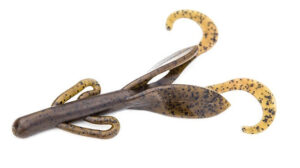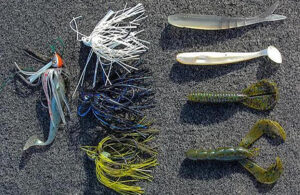Whether you’re walking through your local tackle shop or browsing Tackle Warehouse, making an informed decision on fishing tackle can be a bit overwhelming at times. Even savvy veteran pro anglers will tell you that choosing the right product can be tricky at times. Something as simple as looking for the best bass fishing jig trailers can cause even the best to spin out.
Even though most anglers get comfortable with a company or shape, jig trailers are not a one-size-fits-all deal. Each style, shape and color has a distinct use they’re not always interchangeable. Craws work with some techniques but may not be best suited for all. It is important to match the trailer with the style or presentation for the best results. Good results increase confidence.
What types of trailers are there?
There are four categories of jig trailers, but hundreds of varieties and manufacturers who build them. Pairing the appropriate one with the right jig-at the right time-is the tough part. I categorize trailers like this:
- Chunks – Can be plastic or pork and are usually flat and bulky with no appendages. These are the “sliders”.
- Craws – Plastic trailer that can fished solo or on the back of a jig. Most have appendages and crawfish pinchers and look like a crawfish. These are the “flappers and thumpers”.
- Creatures – I put products like the Reaction Innovations Beavers, Strike King Space Monkey, Zoom Brush Hogs and Yamamoto Flappin’ Hog in this category. I call these the “exotics”.
- Swimbaits, grubs and twin tails – Self-explanatory, but really shine for swim jig applications. These are the “sleepers”.
Choosing the right one
Some are small, some are big with pinchers, some are subtle and others are loud. Each category of trailer can be switched up to match with the presentation. Some allow the jig to be fished better in cover, some cast better and have the action that fish look for and yet others will either increase or decrease how fast they reach the desired depth. With jigs, anglers have to know if they are targeting sight or lateral line feeders as a first step.
Sight feeders are those that see the bait as a creature while lateral line feeders are normally reactionary biters. Water clarity is part of that equation as well, it’s also about the depth they live in and whether or not current is present.
Don’t get in a rut
As an old-school guy, I catch myself getting into a rut with my selections. I have always used a Zoom Super Chunk for a fast fall rate and wide body, high-profile applications like fishing deep or off of steep points. I want the jig to look like an escaping crawdad and I want it to look as natural as possible. The Super Chunk is my go-to option but I have also found that craws with small pinchers do a lot of the same things I like about flat-bodied trailers, only with a touch of added action that site feeders seem to really like.
Don’t forget fall rate in your selections
Rate of fall can be critical, especially in medium depths of 12 to 15 feet. Flat-bodied trailers will fall much faster than those with appendages. Typically craw-style trailers are best utilized when fishing near the bottom or in clear water. Football, Arkie, flipping, skipping and all-purpose jigs vary by presentation but can also be adjusted based on the trailer you choose. Think about that the next time the bite is tough and try a different trailer.
Switching to a full flowing craw-style crawfish trailer like the Zoom Super Speed Craw, the Bizz Baits Killer or Cutter Craw, the Netbait Paca Craw or the Strike King Rage Tail Craw provides more action but also a slower rate of fall. There are several design characteristics that I look at for a trailer of this type such as: Do the pinchers catch water producing vibration? Does it flap or wave when slowly pulled? Does its body shape provide a unique profile?

Color seals the deal
The verdict is still out on the importance of color. Some anglers swear by its importance while others feel action is the difference. Color to many is a confidence thing. There are certain colors that are mainstays like black, blue, orange and brown.
Many will do everything possible to blend the colors of the jig and trailer, but honestly I now hear of more guys looking to clash them due mainly to pressured fisheries and/or changing things up and giving the fish something different. In my area for instance, a black and blue jig and a chartreuse trailer has gained popularity over the years particularly on the river systems.
The old days of a brown jig and a brown trailer or a black jig and a black trailer still work, but experimenting with clashing colors may put a few more fish in the boat for you. Dipping pinchers and appendages with dyes can change things as well. I continue to look for seasonal patterns where color makes all the difference and have yet to see one rise over the rest.

Not all jigs are created equal
Unless the jig used is a swim jig with a horizontal cast-and-wind presentation, most jigs are presented by dropping and lifting. That changes the type of trailer chosen significantly. Swim jigs get bit due largely to reactions to the action and exact swimming depth. For the most part it is a visual bite. With other jigs, both vertical and horizontal presentations get the most bites. Swim jigs are a category in themselves and trailer presentation does truly augment the narrow profile of the jig with split tail trailers, swimbaits, straight tail grubs and worms and other kicking bodies.
Out of the comfort zone changes
The story is simple. Each trailer chosen is no different that choosing the right rod and reel or the best topwater lure. Forcing the type is no different than forcing the technique. For better results in your jig fishing it may be as simple as getting out of your comfort zone and experimenting a bit. I can’t tell you how many times a simple little tweak made my day go from the outhouse to the White House by not being set in my ways or just grabbing what I had handy. It just changed the game.
Check your arsenal of trailers and see if you have a good selection. Don’t be afraid to go off the grid and get crazy with your selections. Experiment, note the conditions and never settle for tried and true. It just may help you put a few more fish in the boat for you.












